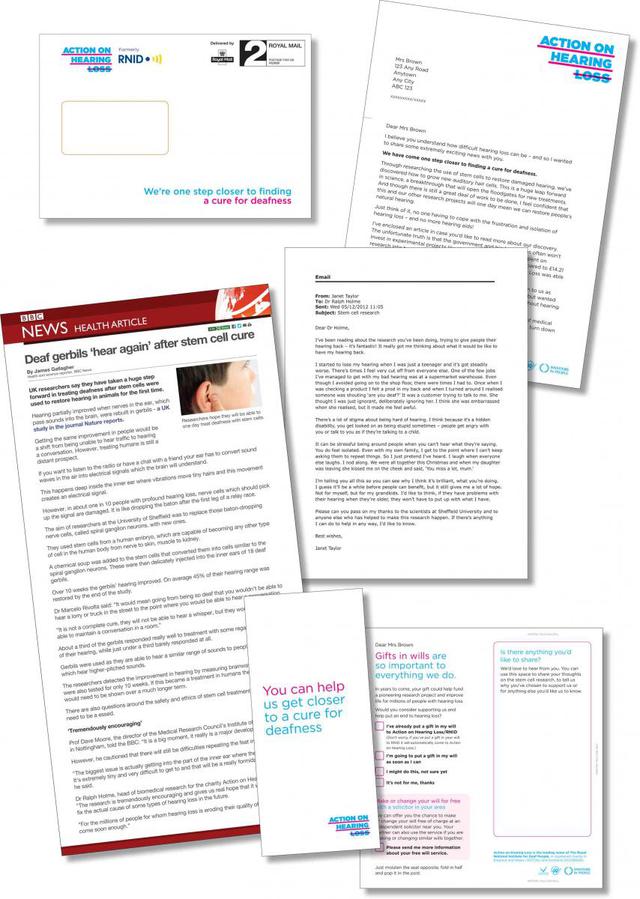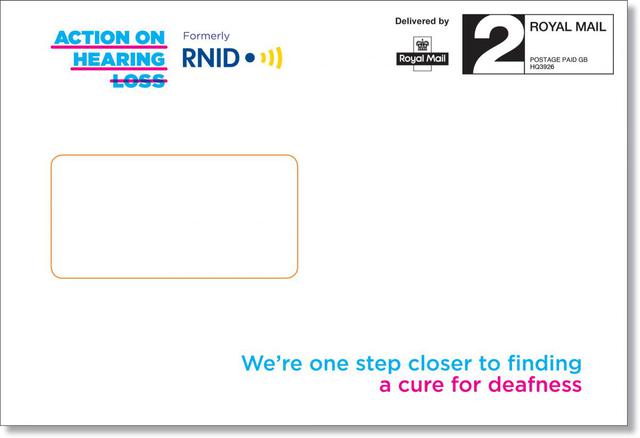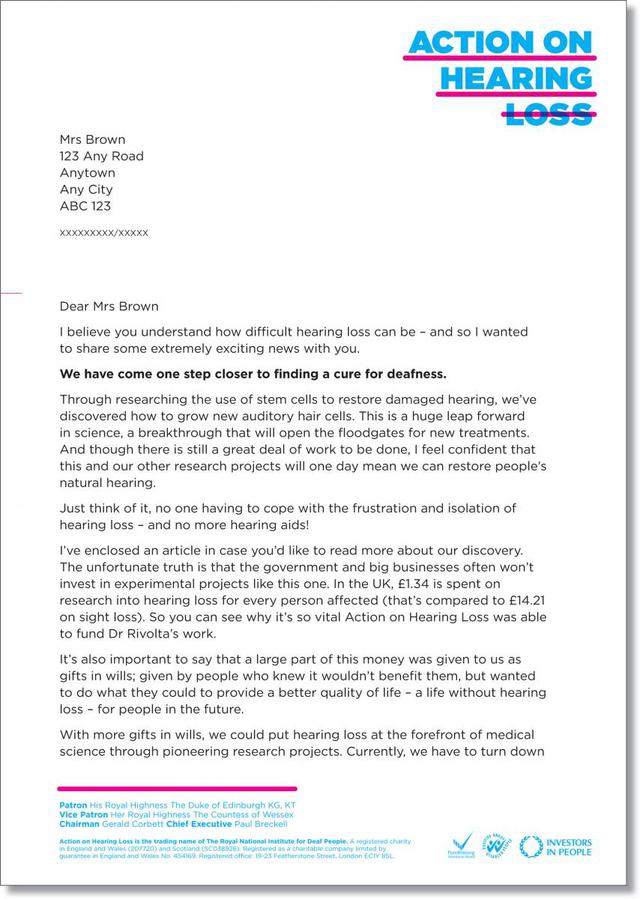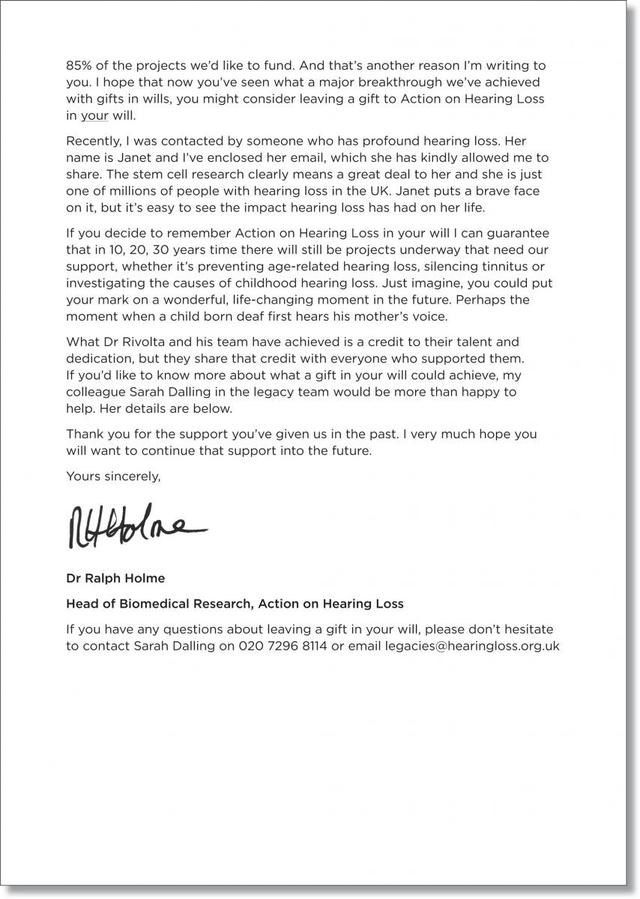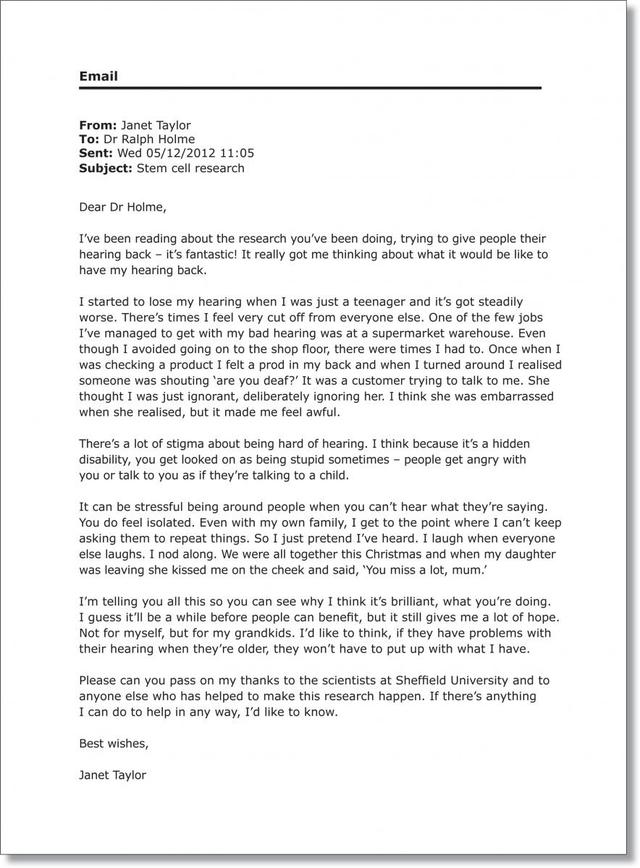Action on Hearing Loss: put a gift in your will
- Exhibited by
- Karin Weatherup, creative director, Burnett Works.
- Added
- March 15, 2013
- Medium of Communication
- Direct mail
- Target Audience
- Legacy
- Type of Charity
- Disabilities
- Country of Origin
- UK
- Date of first appearance
- January, 2013
SOFII’s view
A powerful, yet very simple mailing that convinced people that making a gift in a will really does make a difference to someone with a hearing impairment. It makes the very best of positive reporting from none other than the authoritative BBC and uses statistics to good advantage.
It is great to see that future communications from different parts of the organisation will take into account what each will be saying to these special donors.
Creator / originator
Burnett Works.
Summary / objectives
To encourage best prospect donors, who supported the charity in various ways, to put a gift in their will.
Background
Like many charities, Action on Hearing Loss has a diverse range of services, some supported by grants from local authorities, some very dependent on voluntary income.
We chose biomedical research into a cure for hearing loss as the focus for this mailing to encourage donors to put a gift in their will to Action on Hearing Loss for several reasons. Data shows that their donors find biomedical research particularly appealing. It’s an area of the charity’s work that leans heavily on legacy income. A project funded by Action on Hearing Loss had just delivered a breakthrough, trumpeted widely in the media, that could one day lead to being able to restore natural hearing – proof that legacies can achieve great things. But research into hearing loss is hugely underfunded in the UK and we had statistics to demonstrate that.
Special characteristics
This mailing is very simple and straightforward to read. It comes from the head of biomedical research at the charity.
It appeals to the heart – there’s an email from a woman who has severe hearing loss, who had got contacted the charity after reading about the research breakthrough and offered her help in any way that was useful.
And it appeals strongly to the head too – there’s a reproduction of an article that appeared on the BBC’s website into the breakthrough research project funded by Action on Hearing Loss, detailing what it achieved and where it could lead. There was lots of media coverage we could have chosen, but we thought the BBC article would be the most acceptable and authoritative to the most people. A charity waxing lyrical about its own work is less convincing than the BBC doing it for them!
Fundraising mailings often lack anything really factual that illuminates the opportunity for a donor or pledger – something the brain can snag on beyond a moving story. Fortunately, Action on Hearing Loss had some figures that demonstrate the yawning chasm between funding for research into sorting out hearing loss (£1.34 for every person affected) and sight loss (£14.21). We used this, alongside explaining that business and government don’t really like investing in experimental science – so the kind of riskier but exciting stuff AOHL funds, and donors can help with if they put a a gift in their will, is really needed. And this project is proof it pays off.
Influence / impact
The acquisition mailing to 25,000 people – donors of the charity with a propensity to give – generated 43 people who said they had already put the charity in their will, 30 planning to do it ‘as soon as I can’, 310 who ‘might do it’, and 143 ‘send me information about your free will service’. There was also an additional, slimmer mailing that went to a group who had previously put their hands up as being interested in putting a gift in their will. This generated a further 20 ‘I’ve done it already’, 33 ‘as soon as I can’, 108 ‘I might’ and 43 ‘free will info please’.
The mailings were also supported by a small telemarketing campaign, carried out by Listen.
The charity has worked out that this campaign is likely to generate around £2 million in the future. This is based on what it knows about how many legacies are actually received from pledgers and intenders etc, how many are likely to be residuary and pecuniary gifts, and the average value of the gifts.
Details
The outer envelope was tested: blank against a coverline.
Blank won.
Merits
It shows that simplicity is always powerful. And it works very hard to knock down the barriers to people believing that a gift in their will does something really interesting and important. It uses external credibility (BBC). It uses an illuminating fact. It uses a real person’s testimony as to the value of the research people are being asked to help fund. And it is careful to show that a gift received well into the future (nobody wants to pop off now!), will still be needed and can achieve something different to a donation given now (restore natural hearing rather than assist people who have to live with impaired hearing).
Follow-up of the project
The people who put their hands up as a result of this mailing to say they’ve put a gift in their will already, or are planning to, or are thinking about it, will now be treated carefully and differently. They will receive fewer mailings from the direct marketing team; and updates about what gifts in wills can achieve will take into account what they’ll be hearing about from other parts of the organisation.
Other relevant information
Download a PDF version of the packshot.


